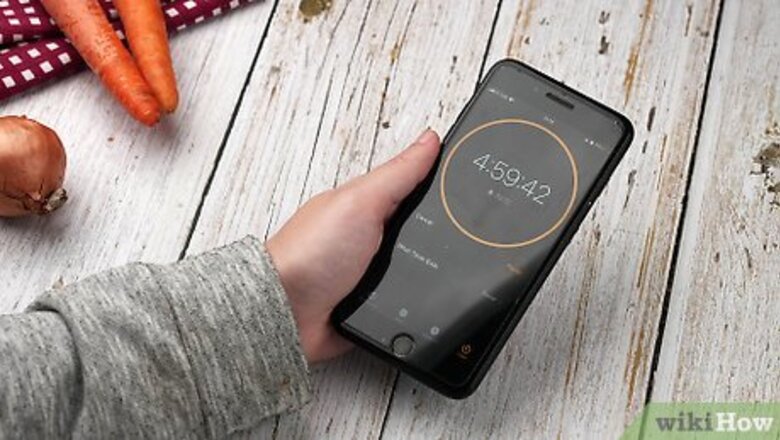
views
- To use the refrigerator, place your frozen chicken on a paper towel-lined plate or bowl covered in plastic wrap at least 12-24 hours before cooking.
- Or, place your chicken in a plastic bag and sit it in a bowl of cold water for up to 3 hours or so. Refresh the cold water every 30 minutes.
- Or, place unwrapped frozen chicken in the microwave and warm on the “defrost” setting for 2 minutes. Continue defrosting in 1-minute intervals until thawed.
Defrosting Chicken in the Refrigerator
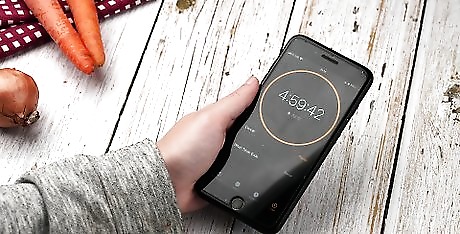
Begin thawing your chicken at least 12 hours in advance of cooking. Using the refrigerator is the safest way to defrost your chicken because it keeps your meat out of the “Danger Zone” where bacteria can grow (40-140°F (4-60°C)), but it is the method that takes the longest. The exact amount of time it takes to defrost depends on the cut and weight of the chicken: Individual chicken breasts, thighs, or drumsticks typically take 12-24 hours to fully thaw. A small whole chicken or clump of chicken frozen together that weighs under 5 lb (2.3 kg) will take about 24 hours. Defrosting a whole chicken will take about 24 hours per 5 lb (2.3 kg) to fully thaw.
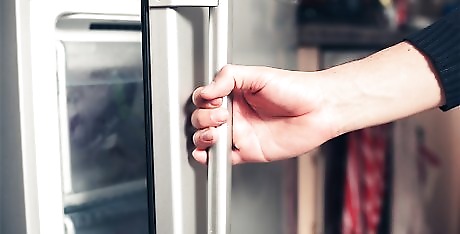
Remove your chicken from the freezer and place it in the fridge. Place the chicken on a plate or bowl lined with paper towels, covered in plastic wrap to catch any drippings as it thaws. To be extra cautious, place the chicken on the lowest shelf in the fridge so that any escaping juice doesn’t drip on and contaminate other food.
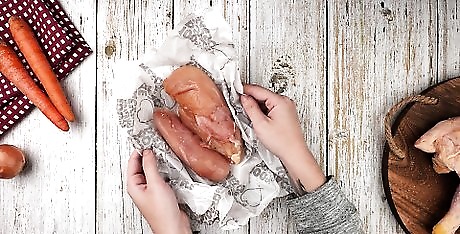
Remove and cook your chicken once it’s fully thawed. Look for chicken that’s no longer covered in frost and is squishy to the touch. If you’re unsure, cut a small slit in the thickest part of the chicken and slip your fingertip inside—the flesh should be soft without any ice crystals. If you’re thawing a whole chicken, place your hand in the major cavity of the chicken. If there are ice crystals within the chicken, it needs to be defrosted longer.
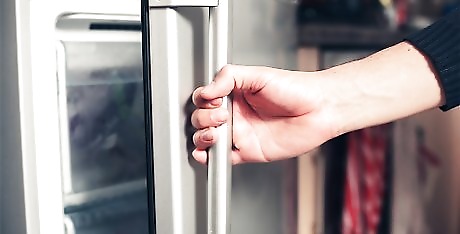
Keep thawed chicken in the fridge if you’re not cooking it right away. Chicken that has been thawed in the refrigerator can safely stay there for 1-2 days. Store your thawed chicken in the coldest part of your refrigerator (typically the back of the lowest shelf). This will keep your chicken bacteria-free for a longer amount of time. Uncooked chicken can only be refrozen if it’s been thawed in the refrigerator. Do not refreeze uncooked chicken after thawing with any other method.
Defrosting Chicken in Cold Water
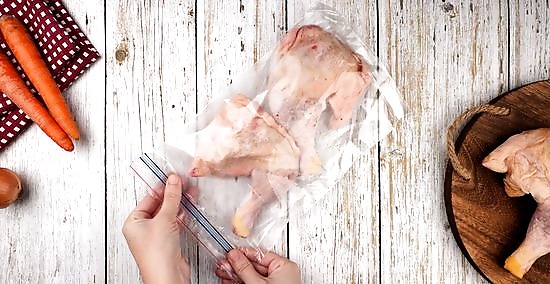
Seal your chicken in a plastic freezer bag if it’s not already wrapped. The leak-proof bag will keep bacteria from contaminating the chicken during the thawing process, as well prevent the chicken’s bacteria from contaminating the surfaces around it. If the chicken is still in its original packaging, use that. Do not use the chicken’s original packaging if it’s been torn or damaged in any way. Cold water thaws chicken faster than the refrigerator, but requires more of your attention throughout the process. A pound (455 g) of chicken may take an hour or less to thaw, while a 3-4 pound (1.4-1.8 kg) package may take 2-3 hours. A whole chicken takes about 30 minutes per pound (455 g).

Place the bagged chicken in a bowl full of cold water. Make sure that the bowl is large enough for the chicken to be fully submerged in water. Do not use warm or hot water—this brings the chicken into the “Danger Zone” and may encourage bacteria growth. If you’re thawing a whole chicken, use your kitchen sink if you can’t find a bowl large enough to hold it.
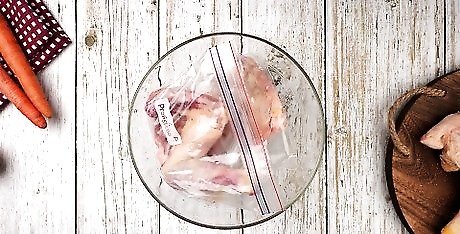
Change the water every 30 minutes to keep the chicken at a safe temp. When the water is allowed to warm up, the chicken may enter the “Danger Zone” while it thaws, resulting in bacteria growth. Empty and refresh the cold water about every half hour to keep the chicken thawing at a safe rate. If you’re unavailable to change the water every 30 minutes, ask a family member or someone who will be around to change out the water for you. Alternatively, place the bagged chicken in the sink and allow cold water to run over it until defrosted. However, this method wastes a lot of water and doesn’t shave much time or effort off of letting the chicken sit in cold water, so it may not be worth it.
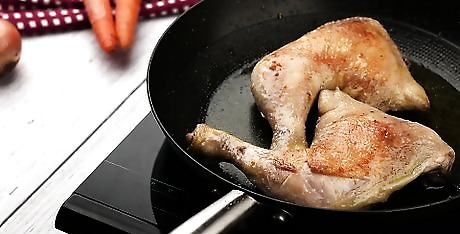
Plan to cook all of the chicken right away once it’s thawed. There’s a slight chance that some bacteria may grow during the cold water thawing method if the chicken ever sits in the “Danger Zone” (for example, if you were late to change the cold water). To protect yourself, cook the chicken right away to kill any germs. Once the chicken is cooked, refrigerate or freeze it again for storage. Do not freeze or refrigerate raw chicken that has been thawed with the cold water method without cooking it first. If the plastic bag was damaged or punctured during thawing, make sure to thoroughly wash the bowl or sink and counters to kill any chicken germs that may have spread.
Defrosting Chicken in the Microwave
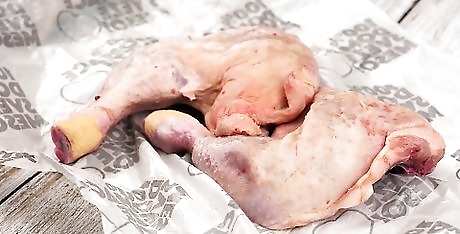
Use the microwave if you plan to cook the chicken immediately. Microwaving frozen chicken leads to uneven thawing (some parts of the outside may even begin to cook in the microwave), which can affect the texture, moisture, and taste of the chicken later. It also warms the chicken into the “Danger Zone,” making bacteria growth more likely. The microwave is best for boneless, skinless chicken breasts since they’re more likely to thaw evenly compared to other cuts or whole chickens.

Unwrap your chicken and place it on a microwave-safe dish. Remove any plastic wrap or packaging before microwaving. If possible, use a bowl or a plate with raised edges so that no juice leaks while the chicken defrosts.

Microwave the chicken on “defrost” for 2 minutes to start. After 2 minutes have passed, let the chicken sit for 1 minute and then check to see if it has thawed. If not, continue to defrost in 1-minute intervals until the chicken is thawed all the way through. Be careful to follow your microwave's specific instructions and power levels to make sure that the chicken does not start to cook. If your microwave doesn’t have a defrost setting or you’re not sure how much power to use, set the power to 20%. Depending on the thickness of the chicken and your particular microwave, this method may take up to 10 minutes.
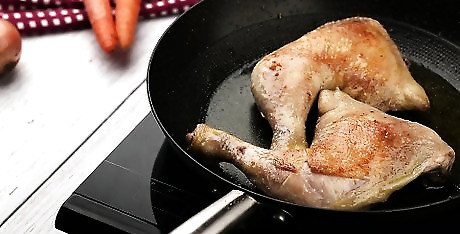
Cook your chicken immediately after microwaving. Since microwaving may partially cook and unevenly warm your chicken, bacteria is a concern. Plan to cook your chicken right away once it’s thawed to kill any germs that may have gathered while defrosting. Do not refrigerate or freeze your microwave-thawed chicken until you’ve cooked it.
Can you cook chicken from frozen in a hurry?
Yes—just allow 50% more time for frozen chicken to cook. Cooking from frozen is safe if you’re in a hurry or don’t have enough time to thaw your chicken out ahead of time. Just know that it will take 50% longer to cook than thawed or fresh chicken. For example, if a recipe asks you to bake a chicken breast for 1 hour, then you’d have to let it bake for 90 minutes if you throw it in the oven straight from the freezer. Always check the temperature of your chicken with a food thermometer to ensure it’s cooked to an internal temperature of at least 165 °F (74 °C), especially when cooking from frozen. While cooking from frozen is safe, it may make timing the other parts of your meal more difficult. For instance, if you’re baking frozen chicken breasts and vegetables together, your vegetables may be overcooked by the time your frozen chicken is ready.



















Comments
0 comment